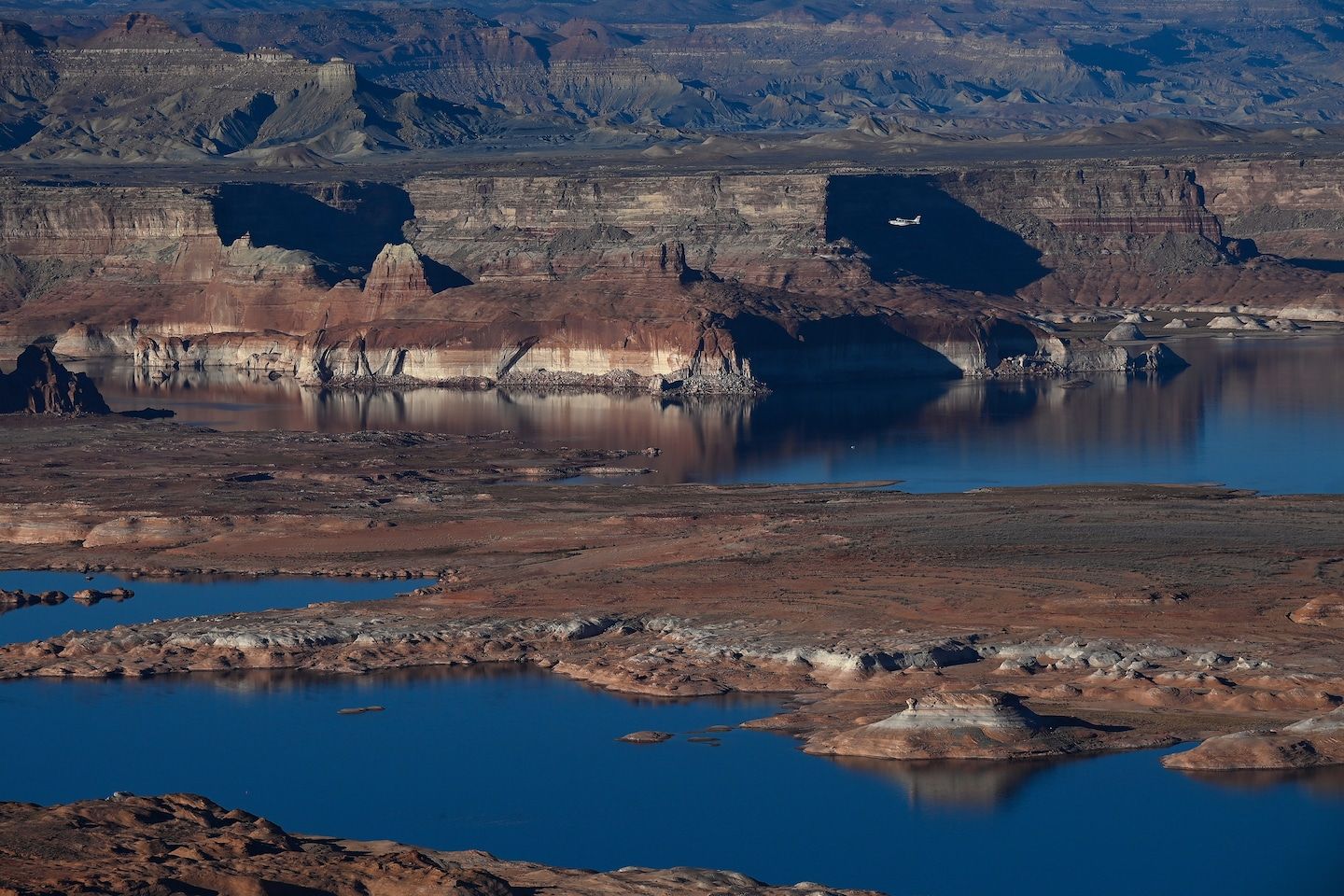Colorado River states, Biden make deal to protect drought-stricken river
Listen 7 min Comment on this story Comment Gift Article Share
The states along the Colorado River — a vital source of water and electricity for the American West — reached an agreement with the Biden administration to conserve an unprecedented amount of their water supply in exchange for $1.2 billion in federal funding, state and federal officials said on Monday.
After nearly a year of negotiations and multiple missed deadlines, the deal amounts to a temporary solution intended to protect the country’s largest reservoirs — Lake Powell and Lake Mead — from dropping to critical levels over the next three years. These reservoirs have fallen dramatically as the warming climate and the past two decades of drought have pared down the river’s natural flow by some 20 percent.
To stabilize the river, the three states that comprise the Lower Basin — California, Arizona, and Nevada — have agreed to voluntarily conserve 3 million acre-feet of water over the next three years, which amounts to 13 percent of these states’ total allocation from the river. The Biden administration has committed to compensating the states for three quarters of the water savings — or 2.3 million acre-feet — which would amount to some $1.2 billion in federal funds, the people familiar with the talks said. The money from the Inflation Reduction Act would pay farmers, Native American tribes, cities and others who voluntarily forego their supplies.
Advertisement
“There are 40 million people, seven states, and 30 Tribal Nations who rely on the Colorado River Basin for basic services such as drinking water and electricity,” Interior Secretary Deb Haaland said in a statement on Monday. “Today’s announcement is a testament to the Biden-Harris administration’s commitment to working with states, Tribes and communities throughout the West to find consensus solutions in the face of climate change and sustained drought.”
The deal, which was first reported Monday by the New York Times but whose outlines The Washington Post detailed last week, came together over the past month in a series of conference calls among state and federal officials and meetings in cities such as Las Vegas and Phoenix. It was pushed along by the publication last month of the Interior Department’s environmental review of reservoir operations — which outlined two alternatives for how to distribute cuts in water usage among the Lower Basin states.
Neither of those alternatives were particularly palatable to the states and pushed them toward a compromise. The timing of that federal process also forced the issue, as the states had until May 30 to issue formal comments on the Interior Department’s alternatives. As part of the new deal, Interior plans to suspend the comment period and instead analyze the new proposal in the federal environmental review process. The goal is to ultimately sign a record of decision that revises the 2007 rules that govern operations at Lake Powell and Lake Mead.
Advertisement
Tom Buschatzke, Arizona’s commissioner to the Colorado River talks, stressed on Monday that the deal did not represent a final outcome and the parties have agreed to a new proposal to be analyzed by the Interior Department in the months ahead.
“It is important to note that this is not an agreement, this is an agreement to submit a proposal and an agreement to the terms of that proposal to be analyzed by the federal government,” Buschatzke told reporters. “That is a really critical point for everyone to understand.”
The Glen Canyon Dam in Page, Ariz., performed high flow experiments on April 25. (Video: Erin Patrick O'Connor/The Washington Post)
Arizona Gov. Katie Hobbs (D), California Gov. Gavin Newsom (D), and Nevada Gov. Joe Lombardo (R) sent a letter to Interior supporting the plan to scrap the draft environmental impact statement published last month and instead analyze the new deal.
“We have been informed that under almost all modeling conditions, the Lower Basin States consensus proposal would result in greater protections for Lake Mead and Lake Powell than either of the alternatives analyzed in the” existing environmental impact statement, the three governors said.
Advertisement
The Colorado River is a major source of drinking water for some of the country’s largest cities — such as Los Angeles and Phoenix. The river irrigates swaths of farmland that keep supermarkets across the country stocked with vegetables in winter. And it provides cheap hydropower to millions of people in the West.
But by early last year, Biden administration officials became increasingly concerned that the water levels in Lake Mead and Lake Powell could soon drop so low that hydroelectric dams would have to shut down. The paltry amounts of runoff reaching these lakes — even in years when the Rocky Mountains got a decent snowpack — added to fears that “dead pool” was on the horizon, when the reservoirs might fall so low that dams would effectively block the river from flowing out.
In June, U.S. Bureau of Reclamation Commissioner Camille Calimlim Touton testified before the Senate that states needed to stop using 2 million to 4 million acre-feet of water — up to one-third of the river’s annual average flow — or the federal government would step in to protect the river.
Advertisement
The last time the seven states of the Colorado River basin — Arizona, California, Nevada, Utah, Colorado, Wyoming and New Mexico — had negotiated cutbacks in their usage, it had taken nearly six years. This time, Touton gave the states two months to reach a deal.
That launched an intense negotiation that blew through two deadlines and at times involved bitter disputes between the parties. One central tension was between Arizona and California, the two states that pull the most from Lake Mead. If the cutbacks in water use followed the legal priority system Arizona would be hit hard, risking the water supply to Phoenix and Tucson. If the states deviated from the priority system and distributed cuts equally among the Lower Basin, California and its powerful farming regions, such as the Imperial Valley, stood to take a major blow.
The new deal among the states would require the Lower Basin to conserve at least 3 million acre-feet by 2026, with at least half of that coming this year. An acre-foot is about 326,000 gallons, what it would take to cover an acre of land with a foot of water.
Advertisement
Arizona, California, and Nevada have not yet finalized where all these water savings will come from within their states.
The deal comes with emergency provisions if the reservoirs fall farther than expected in the next three years. The states would take additional action to protect reservoir elevations of 1,000 feet above sea level at Lake Mead and 3,500 feet at Lake Powell.
The heavy rain and snow that battered Western states this winter helped ease the crisis on the Colorado River and provided time and space for negotiators to reach a deal. As spring runoff begins, the reservoirs have started rising and the dire predictions about reaching critical thresholds have receded, for now.
The 3 million acre-feet in reductions over three years is less than some of the more dire scenarios that were laid out in the federal government’s environmental review. But state and federal officials have said they are comfortable that these reductions will be enough to protect the reservoirs until 2026, when the states and the federal government have been planning a major renegotiation of how the Colorado River gets divvied up.
Advertisement
As part of this week’s agreement, the parties now expect to formally begin the 2026 process soon.
“The Plan set forth by the Lower Basin States is not a panacea for the river, but rather a consensus solution that will help manage near-term water demands while serving as a bridge to negotiate the post-2026 operating criteria,” said John Entsminger, the Southern Nevada Water Authority General Manager and state’s commissioner to the negotiations. “The Colorado River Basin has a warmer and drier future ahead and reducing water use, increasing water efficiency, and maximizing water recycling and reuse is paramount to a sustainable future for the 40 million people that depend upon this critical water supply.”
GiftOutline Gift Article
Source: The Washington Post


